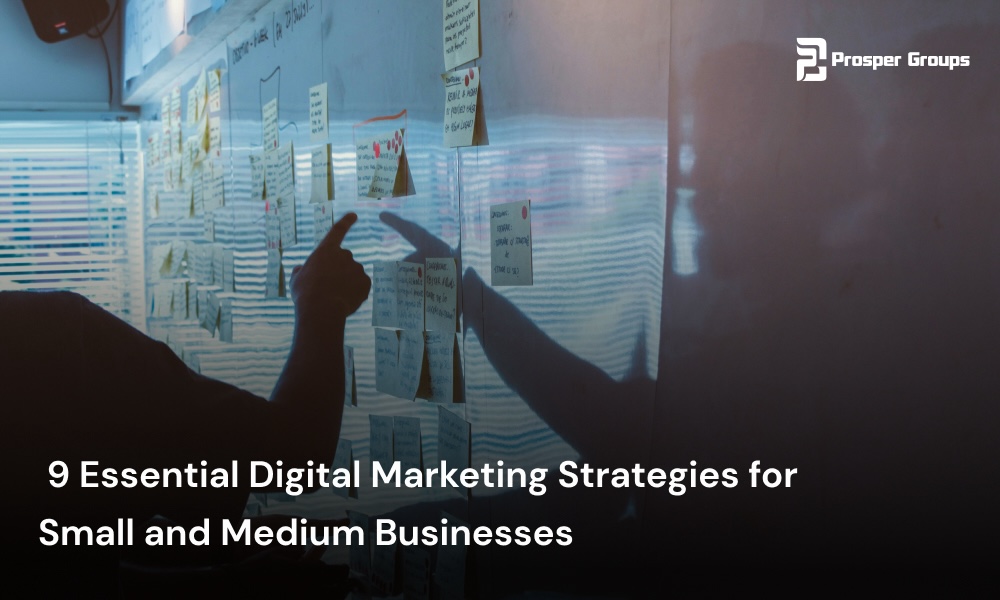
In today’s digital world, small and medium businesses face several challenges when it comes to selling and marketing their products and services.
With the constant development of technology and the ever-changing digital landscape, businesses need to adapt and embrace new strategies to stay competitive and reach their target audience effectively. This article delves deep into nine essential digital marketing strategies that can help all small and medium businesses thrive and grow digitally.
The foundation of any successful digital marketing strategy is having a strong website that serves as a virtual storefront for the customers. By developing a user-friendly website with responsive design, clear navigation, quality content, and search engine optimization, businesses can establish credibility, gain follower’s trust, and convert visitors into customers.
In addition to a strong website, businesses can implement search engine optimization (SEO) to improve their visibility and ranking in search engine results pages. Content marketing, social media marketing, email marketing, pay-per-click (PPC) advertising, influencer marketing, and customer reviews and testimonials are also other key strategies to drive traffic, engage with customers, and increase conversions.
Let’s review some of these strategies in more detail:
Develop a Strong Website
A professionally designed, user-friendly website is the key to any successful digital marketing strategy. It works as a resource, providing customers with significant information about your business, products, or services.
A strong website can be a huge help for businesses to establish credibility, build trust, change visitors into customers, and drive conversion. When you are developing your website, consider the following key elements:
Responsive design: Ensure your website is optimized for different devices, like desktops, laptops, tablets, and smartphones.
Clear navigation: Make it comfortable for visitors to find what they’re looking for with a simple, intuitive website menu.
Content quality: Provide valuable, engaging, useful, and regularly updated content that aligns with your target audience’s expectations.
Search engine optimization (SEO): Develop your website for search engines to improve visibility and drive organic traffic.
Leverage Search Engine Optimization (SEO)
SEO stands for the process of improving the visibility and ranking of your website in search engine results pages (SERPs) through numerous techniques, including keyword research, on-page and off-page optimization, and link building. By optimizing your website for search engines, you can increase organic traffic, drive more qualified leads, and boost conversions.
To get started with Search Engine Optimization, please focus on:
Keyword research: Identify relevant keywords and phrases your target audience uses to search for your products or services.
On-page optimization: Optimize your website’s title tags, meta descriptions, header tags, and content with target keywords.
Link building: Build high-quality backlinks from authoritative sources to increase your website’s authority and ranking.
Content Marketing
Content marketing is creating and distributing valuable, relevant, and consistent content to attract and retain a targeted defined audience. By providing useful content, you can establish your business as a thought leader in your industry, build trust with your target audience, and drive conversions.
To develop a successful content marketing strategy, consider the following factors:
Content types: Create a combination of blog posts, videos, infographics, eBooks, and social media posts to cater to different learning styles and preferences.
Content calendar: Create Plan and schedule content in advance to ensure you are posting consistently and reduce last-minute scrambles.
Content promotion: Promote your content through social media, email newsletters, and paid advertising to increase visibility and reach.
Social Media Marketing
Leverage Social media platforms, such as Facebook, Twitter, and LinkedIn, offer a cost-effective way to reach a large audience, build brand awareness, and drive website traffic.
By creating useful attractive content and interacting with your audience, you can build a loyal community of followers and customers who will advocate for your business.
To get started with using social media marketing, consider:
Channel selection: Consider the social media platforms where your target audience is most active.
Content creation: Create content that is valuable to your audience, including visuals, videos, and interactive content.
Engagement: Respond to comments, messages, demands, and reviews in a timely and personalized manner.
Email Marketing
Email marketing is sending targeted, personalized messages to customers and followers to nurture leads, drive conversions, and build loyalty. By building an email list and creating engaging campaigns, you can stay at the top of the mind of your audience and drive revenue.
To develop a successful email marketing strategy, consider:
List building: Build an email list through opt-in forms, lead magnets, and customer interactions.
Segmentation: Segment your list based on demographics, behavior, and preferences to create targeted campaigns.
Personalization: Personalize and tailor your emails with the recipient’s name, interests, and preferences.
Pay-Per-Click (PPC) Advertising
PPC advertising involves making ads that appear on search engines and websites at no cost, charging you only when a user clicks on your ad. By targeting specific keywords and demographics, you can drive targeted traffic to your website and increase customers.
To begin with PPC advertising, focus on:
Keyword research: Find relevant keywords and phrases with high search volume and low competition.
Ad creation: Create compelling and persuasive ad copy, headlines, and landing pages that resonate with your target audience.
Budgeting: Set a budget and bid strategy to ensure maximum ROI.
Influencer Marketing
Influencer marketing is partnering with influencers who have a large following and popularity in your target audience to promote your products or services. By leveraging an influencer’s credibility and reach, you can increase brand awareness, drive website traffic, and generate leads.
To implement a successful influencer marketing strategy, consider:
Influencer selection: Choose influencers who are aligned with your brand values, target audience, region, and niche.
Content collaboration: Collaborate with influencers to create sponsored content, product reviews, or tutorials.
Tracking and measurement: Track the performance of your influencer campaigns to measure ROI and optimize future collaborations.
Customer Reviews and Testimonials
Customer reviews and testimonials are crucial for building trust and credibility with potential customers.
By showing you have positive reviews and testimonials, you can gain trust, improve brand reputation, and drive customer loyalty.
To leverage customer reviews and testimonials, try:
Review collection: Tell your customers to leave reviews on your website, social media, or review platforms.
Testimonial creation: Create case studies, videos, or written testimonials that showcase customer success stories.
Display and promotion: Display reviews and testimonials prominently on your website and social media channels.
Analytics and Measurement
Analyzing and measuring the performance of your digital marketing efforts is undeniable for identifying what strategies are working and where there are flaws and spaces you can improve. By tracking key performance indicators (KPIs) such as website traffic, conversion rates, and engagement metrics, you can optimize your campaigns for better results.
To effectively measure your digital marketing efforts, consider:
Setting up analytics tools: you can use tools like Google Analytics, social media analytics, and email marketing platforms to track and measure your performance and whether it is working or not.
Defining KPIs: Establish key performance indicators that align with your business goals, such as conversion rates, click-through rates, and return on investment.
Analyzing data: Review and analyze data constantly to identify trends, insights, and areas for improvement.
In conclusion, implementing these nine essential digital marketing strategies can help small and medium businesses stand out in today’s competitive digital landscape. Having a strong website is crucial, while search engine optimization (SEO) improves visibility and organic traffic. Content marketing, social media marketing, email marketing, pay-per-click (PPC) advertising, influencer marketing, and customer reviews and testimonials all play a vital role in building brand awareness, engaging with customers, and driving real traffic.
Furthermore, analyzing and measuring the performance of digital marketing efforts through analytics and key performance indicators (KPIs) is undoubtedly essential for optimizing campaigns and achieving goal results. By tracking metrics, businesses can identify trends, insights, and spaces to improve.
By focusing on developing a strong online presence, creating valuable content, engaging with customers on social media, and leveraging influencer partnerships, businesses can reach their target audience effectively.
Overall, by incorporating these digital marketing strategies into their business operations, small and medium businesses can establish credibility, build connections with customers, and ultimately, achieve success in the digital world.

